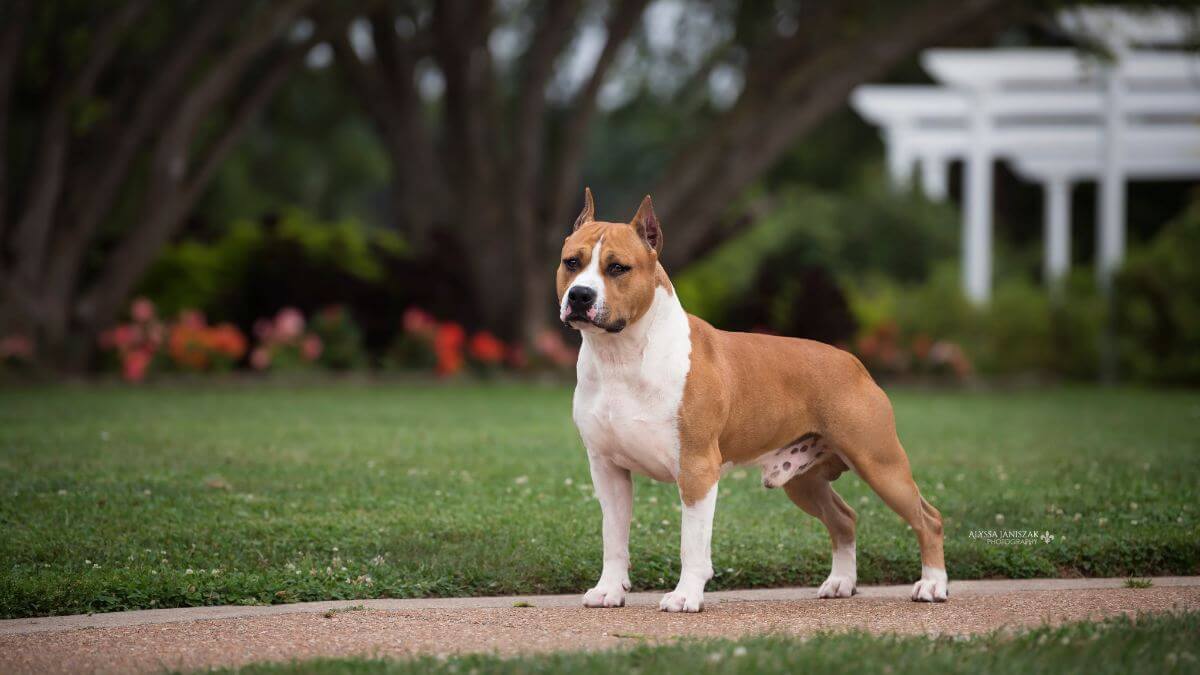


Home » What Can You Do With an American Staffordshire Terrier?

This article was originally published in Showsight Magazine, July 2014 issue.
The answer seems to be pretty much anything. These medium-sized, strong, and agile dogs are well-suited for most dog sports. Their love of life, intelligence, and ability to work with their owners translate well into various competitions and pursuits.
Historically, the breed’s ancestors were developed first in England from old-style working farm bulldogs crossed with working terrier breeds. They inherited the strength and tenacity of both and the agility and intelligence of the terriers. Brought to America in the early 1900s, they were further developed as both farm and homestead dogs and as fighting dogs used in the “sport” of dog fighting. Most have kept their working abilities as farm dogs and the courage, vitality, and tenacity they inherited from the fighting pit.
Today, they are most often beloved pets and great companions. They are highly intelligent and quite responsive to training. Their short coats require little grooming and have very little “doggy odor.” They adjust well to indoor living in the home. They are closely bonded with their families and usually good with children. They can be very quiet house dogs who love to cuddle, but they are always up for a good game. They thrive on attention and are generally not happy without it. They are intelligent enough to get into trouble without an outlet for their energy and prefer a job of some sort that challenges their abilities.
Although there are general breed characteristics, I have always found them to have more strongly distinct personalities than most other breeds. Although I have owned and trained many, no two were ever alike. I find this a big attraction to the breed. They are playful dogs with a sense of humor, and even the eldest dogs are always eager to play. Personally, I can’t imagine my life without these dogs. And I don’t seem to be alone. Many of our active breeders have been in the breed for many years and also can’t imagine life without them.
I have noticed over the years that some professional handlers choose Am Staffs for their personal breed after showing them for other owners. There is just something special about the breed that endears them. One of my favorite traits is that they will comfortably look you right in the eye for long periods without feeling uncomfortable doing so. They seem to be trying to read your brain. They are very direct with humans and always want to be close to their owner. They seem to have a real sense of empathy for humans. Many make good therapy and assistance dogs because of this. They seem to understand when someone is in need of help or comfort.
There is a large variance in their acceptance of other dogs. I have owned some that were very intolerant and some that got along fine with all other dogs. Because of their early fighting background, some have to be managed around other dogs. They are not all naturally aggressive, but some have a low threshold of tolerance around other dogs. Socialization and training can make a big difference here. But care should always be taken until you understand your dog’s personal level. With training, even intolerant dogs can work safely around other dogs.
Training is a must for this breed, as it keeps them out of trouble and gives them something to apply their intelligence to. They love to test their strength against hard tasks and love solving a problem. Training works best when it is presented as a game. Am Staffs love a game. Force training can make them quietly resist, but fun is always fun. Competitive sports are right up their alley. Many Am Staffs train in several venues and compete successfully in all. My own dogs have titled in AKC obedience competitions through Utility titles, AKC agility competitions through Masters titles, and even Canine Freestyle. Once, on a dare, I successfully earned a Schutzhund BH title on one of my obedience dogs, although he had no prior training in that sport. Am Staffs also successfully compete in dock diving, tracking, Schutzhund, carting/drafting, weight pull, Earthdog trials, sprint racing, lure coursing, frisbee, and flyball. Many still have the instinct to herd and are great with farm animals. They are also excellent varmint hunters.
Some years ago, my obedience-trained dogs and I belonged to a square dance dog group that performed at events, dog shows, and even on TV occasionally. We also started a therapy dog performing group that visited hospitals and nursing homes locally. There are many Am Staffs who regularly visit nursing homes and participate in pet therapy. There are also Am Staffs working as seeing-eye dogs and service dogs for people with disabilities. Am Staffs also serve in search and rescue and as drug detection dogs for police. There just doesn’t seem a lot that they can’t do. Although they are not usually very good watchdogs. In general, they trust humans and are friendly and don’t feel very threatened by strangers.
They are certainly not a dog for everyone. They are strong and can be active and demand a lot of time and attention from their owners. But if you want to invest that time and attention, and love to play with your dog, there are many rewards to living with an Am Staff.